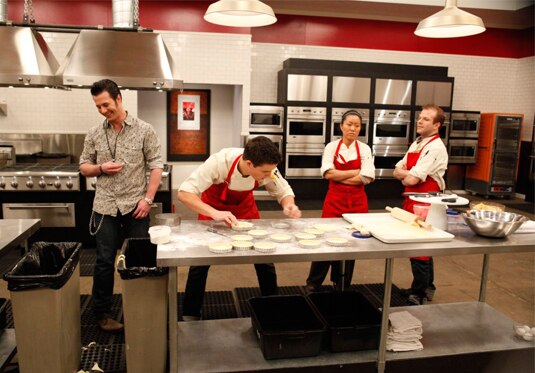Let Them Eat Brioche!
Eli Kirshtein shares a wide belief that Marie Antoinette's famous quote was not translated correctly.

Mise en place is a staple of practically every kitchen in the western world. It is both a noun and a verb. Its literal French translation is installation or setting in place and it really relates to both of those. It is basically all-encompassing of both preparation as well as organization. When you are gathering together the pots and pans you will need for service, that’s mise en place. When you are filling up little pans and containers with everything from salt, to sliced chives, to warmed sauces, they are all mise en place as well. It also includes the mental organization that goes into the whole process, writing prep lists, doing ordering for the next day. It is an important concept, because in a kitchen, preparation is everything.
A strudel is a pastry with its origins tracing back to the Byzantine Empire having evolved from baklava. The word translates from German to vortex or whirlpool. Its outer shell is a basic flour dough that is stretched and pulled into a super thin sheet with the use of rolling pins and hands, in much the same way phyllo dough is made. It made its way into Central and Eastern European culture during the rule of the Habsburg Monarchy that had control of parts of the Mediterranean. It made a transition from being a layered item to a rolled one in the late 1600s with the oldest recorded recipe being a handwritten one from 1696 that is still in the Viennese Library, Wiener Stadtbibliothek. It has now even made its way into being a household staple in Israel from Central European immigrants from the early part of the 20th century. It is most often seen filled with apples or with the soft cheese known as quark.
The flavor that we -- and apparently Eric -- all love that is malt is more a process than it is an ingredient itself. It can be applied to most any cereal grain. It is made when grains are slightly hydrated until they begin to sprout and then stopped by toasting them lightly. They are then usually ground into powders. Often times these grains are then processed further into other products ranging from malted milk powder, to malt vinegar with hundreds of things in between. It adds a toasty nutty quality that helps give richer beers their individual character, and Scotch Whisky its rounded depth. You also see it in everyday items like Whoppers candies and malted milkshakes. The most common forms found in a pastry kitchen is in malted milk powder or in a malt syrup. In pastry it is primarly used to help add flavor more than a technical ingredient and sets a major expectation when the name is said.
Brioche, as made by Zac, is one of the most hedonistic breads that you can imagine. In addition to the usual ingredients, milk, eggs, and butter are added to make a lush, rich bread. The difficult part of the process of making it is to cleanly homogenize the fats into the dough with out over working it and taking away the flakiness that is the hallmark of brioche. Its roots are a little bit ambiguous but its first written appearance is from about 1404 from the French region of Normandy. Yet there are several recipes coming from Eastern Europe and Mediterranean countries that are very similar, which has lead some food anthropologists to believe that it might have Roman origins. It is even believed that Marie Antoinette was misquoted in translation, when she said, “Let them eat cake.” The actual saying was “Qu’ils mangent de la brioche,” or “That they eat brioche.”
Follow me on Twitter at http://twitter.com/elikirshtein



